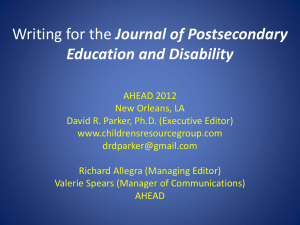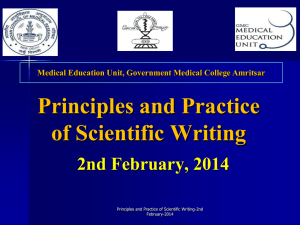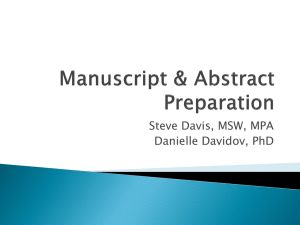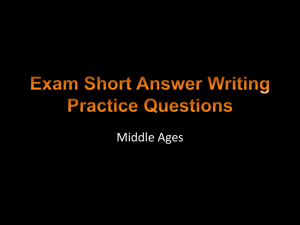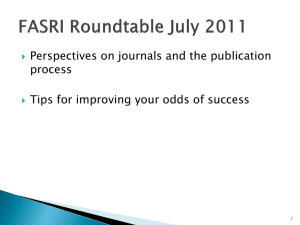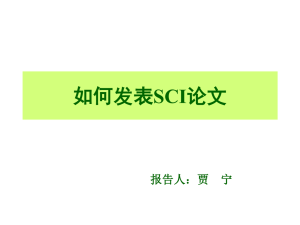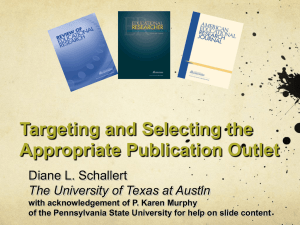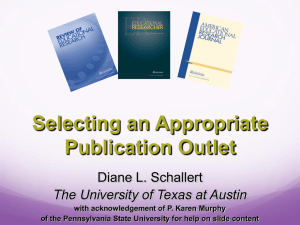Manuscript structure
advertisement
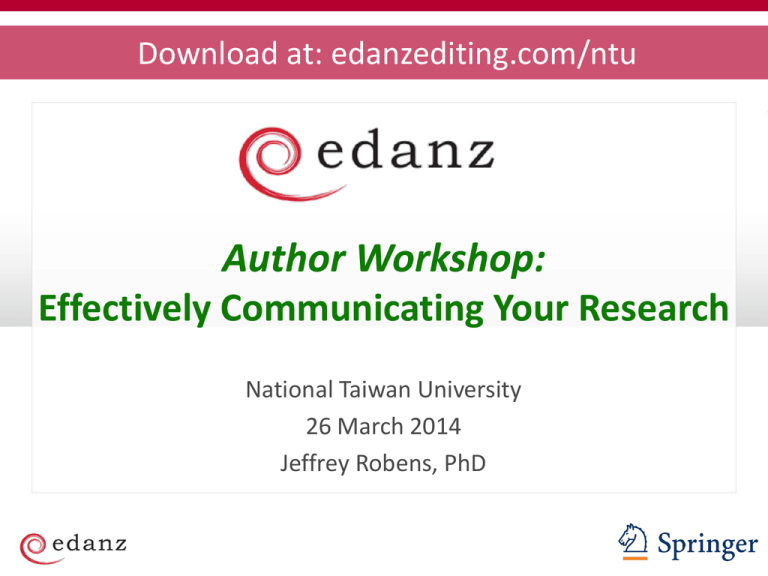
Download at: edanzediting.com/ntu Author Workshop: Effectively Communicating Your Research National Taiwan University 26 March 2014 Jeffrey Robens, PhD About Jeff… University of Pennsylvania Author Peer reviewer Senior Editor Be an effective communicator Your goal should not only to be published, but also to be widely read/cited in the field Choose the best journal to reach your target audience S Logically present your research in your manuscript Prepare effective titles and abstracts Convey the significance of your work to journal editors Properly revise your manuscript after peer review Download at: edanzediting.com/ntu Section 1 Journal selection Journal selection Factors to consider when choosing a journal Aims & scope Readership Open access Indexing Which factor is most important to you? Journal selection Evaluating significance Novelty How new are your findings? Relevance How broadly relevant are your findings? Appeal What are the important real-world applications? Journal selection Journal Selector – www.edanzediting.com/journal_selector Insert your proposed abstract Journal selection Journal Selector – www.edanzediting.com/journal_selector Recommended journals Filter by: Impact factor Publishing frequency Open access Journal selection Journal Selector – www.edanzediting.com/journal_selector Semantic matching terms Journal’s IF, aims & scope, and publication frequency Similar published articles Have they published similar articles recently? Have you cited some of these articles? Journal selection Tips to identify the most suitable journal • Editorials • Review articles • Special issues Identify the interests of the journal editor S Journal selection Tips to identify the most suitable journal Journal editor’s interests Journal A • • • Editorials Review articles Special issues Journal B • • • Editorials S articles Review Special issues Manuscript Journal C • • • Editorials Review articles Special issues Journal selection Tips to identify the most suitable journal • Editorials • Review articles • Special issues Identify the interests of the journal editor S Identify the interests of the readers • Most viewed • Most cited Journal selection Tips to identify the most suitable journal Reader’s interests Journal A • • Most viewed Most cited Journal B • • Most Sviewed Most cited Manuscript Journal C • • Most viewed Most cited Download at: edanzediting.com/ntu Section 2 Manuscript structure Coverage and Manuscript Staffing Plan structure Introduction General introduction Current state of the field Problem in the field Aims Specific aims Coverage and Manuscript Staffing Plan structure Literature review Previous What did earlier studies show? studies How did these lead to more recent studies? What are the knowledge gaps? What is your hypothesis? Current study Coverage and Manuscript Staffing Plan structure Writing the Introduction Identify an important problem State aims that directly address this problem Problem …little has been conducted to qualitatively assess whether selfefficacy and peer influence affect the likelihood of students engaging in academic dishonesty. Aims The purpose of this study is threefold: first, to determine the effect of peer attitudes and behaviour on the likelihood of cheating; secondly, to establish the significance of self-efficacy in promoting academic integrity; lastly, to ascertain effective ways of deterring academic dishonesty. Nora & Zhang Asia Pacific Educ Rev. 2010; 11: 573–584. Coverage and Manuscript Staffing Plan structure Methods Study design Who/what was used Participants Instruments Data collection How it was done Methodology/analyses Constructs/parameters Measures/outcomes How it was analyzed Quantification methods Statistical tests Consult a statistician Coverage and Manuscript Staffing Plan structure Results Logical presentation 1. Initial observation 2. Characterization 3. Application Example: 1. Observe a correlation between depression and Internet use 2. Characterize the severity of depression, time spent online, websites visited 3. Demonstrate decreased Internet use improves severity of depression Coverage and Manuscript Staffing Plan structure Results Logical presentation 1. Initial observation 2. Characterization 3. Application Subsections Each subsection corresponds to one figure Factual description What you found, not what it means Coverage and Manuscript Staffing Plan structure Discussion Summary of findings Relevance of findings Similarities/differences Unexpected results Counter-arguments Limitations Implications for the field Coverage and Manuscript Staffing Plan structure Discussion – the end Why your work is important to your readers The Spanish version of AIDA showed good psychometric properties in Mexico and can be used to assess the construct “pathology-related identity integration vs. diffusion” with reliability, validity, and content equivalence in comparison with the original AIDA questionnaire. This finding supports the cross-cultural generalizability of the underlying concept and confirms the importance of culture-specific test adaption in addition to literal translation of the questionnaire. Nevertheless, some items should be improved. Therefore, the test version of “AIDA Spanish – Mexico” should be further adapted and should be tested in a more heterogeneous population. Conclusion Implications Future directions Kassin et al. Child Adolesc Psychiatry Ment Health. 2013; 7: 25. Coverage and Manuscript Staffing Plan structure Linking your ideas General background Introduction Current state of the field Problems in the field Objectives Methods Results Methodology Results and figures Summary of findings Discussion Relevance of findings Implications for the field Logically link your ideas throughout your manuscript Coverage and Manuscript Staffing Plan structure Linking your ideas Introduction …no research has examined how interacting with Facebook influences subjective well-being over time. Problem We addressed this issue by…measuring in-vivo behavior and psychological experience over time. Objectives Discussion These analyses indicated that Facebook use predicts declines in…subjective well-being… Conclusion Kross et al. PLoS ONE 2013; 8: e69841. Coverage and Manuscript Staffing Plan structure Writing effective conclusions Your conclusion is a summary of your findings Your conclusion should be the answer to your research problem that is supported by your findings Emphasizes how your study will help advance the field Any questions? Thank you! Jeffrey Robens: jrobens@edanzgroup.com edanzediting.com/ntu Download and further reading @JournalAdvisor Follow us on Twitter facebook.com/EdanzEditing Like us on Facebook Who’s hungry? First impressions are important! Download at: edanzediting.com/ntu Section 3 Titles and abstracts Customer Service Titles and abstracts Effective titles Important points Avoid Summarize key finding Contains keywords Less than 20 words Questions Describing methods Abbreviations “New” or “novel” Your title should be a concise summary of your most important finding Customer Service Titles and abstracts Relevance of your aims Abstract Importance of your results Validity of your conclusions First impression of your paper Judge your writing style Probably only part that will be read Customer Service Titles and abstracts Sections of an abstract Concise summary of your research Background Why the study was done Aims Your hypothesis Methods Analyses Results Most important findings Conclusion Conclusion/implications Customer Service Titles and abstracts Unstructured abstract Political thought and behavior play an important role in our lives, from ethnic tensions in Europe, to the war in Iraq and the Middle Eastern conflict, to parliamentary and presidential elections. However, little is known about how the individual's political attitudes and decisions are shaped by subtle national cues that are so prevalent in our environment. We report a series of experiments that show that subliminal exposure to one's national flag influences political attitudes, intentions, and decisions, both in laboratory settings and in “real-life” behavior. Furthermore, this manipulation consistently narrowed the gap between those who score high vs. low on a scale of identification with Israeli nationalism. The first two experiments examined participants' stance toward the Israeli–Palestinian conflict and the Jewish settlers in the West Bank. Experiment 3 examined voting intentions and actual voting in Israel's recently held general elections. The results portray a consistent picture: subtle reminders of one's nationality significantly influence political thought and overt political behavior. Hassin et al. PNAS. 2007; 104: 19757‒19761. Customer Service Titles and abstracts Unstructured abstract Political thought and behavior play an important role in our lives, from ethnic tensions in Europe, to the war in Iraq and the Middle Eastern conflict, to parliamentary and presidential elections. However, little is known about how the individual's political attitudes and decisions are shaped by subtle national cues that are so prevalent in our environment. Background We report a series of experiments that show that subliminal exposure to one's national flag influences political attitudes, intentions, and decisions, both in laboratory settings and in “real-life” behavior. Methods Furthermore, this manipulation consistently narrowed the gap between those who score high vs. low on a scale of identification with Israeli nationalism. The first two experiments examined participants' stance toward the Israeli– Palestinian conflict and the Jewish settlers in the West Bank. Experiment 3 examined voting intentions and actual voting in Israel's recently held general elections. Results The results portray a consistent picture: subtle reminders of one's nationality significantly influence political thought and overt political behavior. Conclusion Hassin et al. PNAS. 2007; 104: 19757‒19761. Journal Editors are busy! Download at: edanzediting.com/ntu Section 4 Cover letters Coverage and Cover letters Staffing Plan Significance Relevance Is your work important? Cover letters areAbstract: the first impression for Firstthe impression readers Journalfor Editor Interesting to their readers? Writing style Coverage and Cover letters Staffing Plan Dear Dr Ellenbogen, A good cover letter Editor’s name Manuscript title Please find enclosed our manuscript entitled “Presenteeism among Taiwanese employees: Personality and job stress”, which we would like to submit for publication as a Research Paper in Anxiety, Stress & Coping: An International Journal. Publication type This study examines presenteeism, the situation in which workers are present at work, but their ability to do their jobs is impaired by physical or mental symptoms. This topic is important to companies as studies have found that the costs of presenteeism can be higher than medical costs associated with treating the underlying conditions. Currently, the relationships between common mental health symptoms and presenteeism, as well as the effects of job strain and workplace social support, are unclear. We aimed to evaluate these relationships and consider the effect of personality traits on both presenteeism and common mental health symptoms. Give the background to the research We used an online questionnaire incorporating several well-established and verified questionnaires to assess presenteeism, mental disturbance, job strain and workplace support, and temperament and character. We found that common mental health symptoms are a good predictor of presenteeism. Although workplace social support is generally agreed to reduce the severity of common mental health symptoms, we found no direct effect on presenteeism. What was done and what was found Our results clearly link presenteeism to common mental health symptoms, and also show the negative effects of strain and poor workplace support. This study is of interest to researchers, managers, mental health clinicians and occupational health specialists interested in the issue of workplace stress and its management. This study is likely to lead to an improved approach to preventing and managing both presenteeism and common mental health symptoms, and is applicable worldwide. Therefore, we feel this manuscript is particularly suitable for Anxiety, Stress & Coping: An International Journal and of great interest to its readers. Interest to journal’s readers We would also like to suggest the following reviewers for our manuscript… Recommend reviewers “Must-have” statements Coverage and Cover letters Staffing Plan Original and unpublished Disclaimers about publication ethics Not submitted to other journals Authors agree on paper/journal “Must-have” statements No conflicts of interest Source of funding Authorship contributions Coverage and Cover letters Staffing Plan Recommending reviewers Where to find them? From your reading/references, networking at conferences How senior? Aim for mid-level researchers Who to avoid? Collaborators (past 5 years), researchers from same institution Look for reviewers who have published in your target journal Coverage and Cover letters Staffing Plan Choose internationally • 1 or 2 reviewers from Asia • 1 or 2 reviewers from Europe • 1 or 2 reviewers from North America Journal Editors want to see an international list for 2 reasons: 1. Shows that you are familiar with your field worldwide 2. Shows that your research is relevant worldwide • Increased readership → increased citations → increased impact factor Section 5 Peer review Peer review The study The What reviewers are looking for Relevant hypothesis Good study design Appropriate methodology Good data analyses Valid conclusions Logical flow of information and Manuscript structure and formatting Results Discussion Methods Figures Abstract and Introduction manuscript Appropriate references High readability Peer review Writing response letters Dr Mark Ellenbogen Editor-in-Chief Address Anxiety, Stress & Coping: An International Journal editor personally 3 September 2013 Manuscript ID number Dear Dr Ellenbogen, Re: Resubmission of manuscript reference No. WJS-07-5739 Thank reviewers Please find attached a revised version of our manuscript originally entitled “Presenteeism among Taiwanese employees: Personality and job stress,” which we would like to resubmit for consideration for publication in the Anxiety, Stress & Coping: An International Journal. The reviewer’s comments were highly insightful and enabled us to greatly improve the quality of our manuscript. In the following pages are our point-by-point responses to each of the comments. Revisions in the manuscript are shown as underlined text. In accordance with the first comment, the title has been revised and the entire manuscript has undergone substantial English editing. We hope that the revisions in the manuscript and our accompanying responses will be sufficient to make our manuscript suitable for publication in the Anxiety, Stress & Coping: An International Journal. Highlight major changes Peer review Agreeing with reviewers Reviewer Comment: In your analysis of the data you have chosen to use a somewhat obscure fitting function (regression). In my opinion, a simple Gaussian function would have sufficed. Moreover, the results would be more instructive and easier to compare to previous results. Agreement Response: We agree with the reviewer’s assessment of the analysis. Our tailored function, in its current form, makes it difficult to tell that this measurement constitutes a significant improvement over previously reported values. We describe our new analysis using a Gaussian fitting function in our revised Results section (Page 6, Lines 12–18). Revisions Location Peer review Disagreeing with reviewers Reviewer Comment: In your analysis of the data you have chosen to use a somewhat obscure fitting function (regression). In my opinion, a simple Gaussian function would have sufficed. Moreover, the results would be more instructive and easier to compare to previous results. Response: Although a simple Gaussian fit would facilitate comparison with the results of other studies, our tailored function allows for the analysis of the data in terms of the Smith model [Smith et al., 1998]. We have now explained the use of this function and the Smith model in our revised Discussion section (Page 12, Lines 2–6). Peer review Disagreeing with reviewers Reviewer Comment: In your analysis of the data you have chosen to use a somewhat obscure fitting function (regression). In my opinion, a simple Gaussian function would have sufficed. Moreover, the results would be more instructive and easier to compare to previous results. Response: Although a simple Gaussian fit would facilitate Evidence comparison with the results of other studies, our tailored function allows for the analysis of the data in terms of the Smith model [Smith et al., 1998]. We have now explained the use of this function and the Smith model in Revisions our revised Discussion section (Page 12, Lines 2–6). Location If rejected, what should you do? Option 1: New submission to the same journal Fully revise manuscript Prepare point-by-point responses Include the original manuscript ID number Option 2: New submission to a different journal Revise manuscript Reformat according to the author guidelines If accepted, what’s next? Promote your work on social networks • Twitter, LinkedIn Respond to post-publication comments Present your work at conferences • Allows you to discuss your work personally with your peers • Get feedback about your work and future directions • Networking and collaborations Be an effective communicator Your goal should not only to be published, but also to be widely read/cited in the field Choose the best journal to reach your target audience S Logically present your research in your manuscript Prepare effective titles and abstracts Convey the significance of your work to journal editors Properly revise your manuscript after peer review Any questions? Thank you! Jeffrey Robens: jrobens@edanzgroup.com edanzediting.com/ntu Download and further reading @JournalAdvisor Follow us on Twitter facebook.com/EdanzEditing Like us on Facebook

